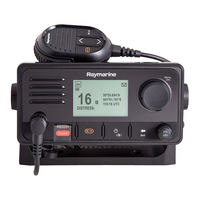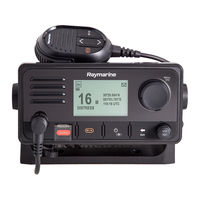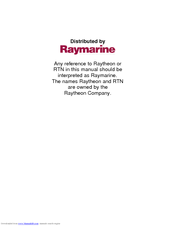Raymarine Ray 53 Manuals
Manuals and User Guides for Raymarine Ray 53. We have 5 Raymarine Ray 53 manuals available for free PDF download: Installation And Operation Instruction Manual, Installation & Operation Instructions, Troubleshooting Manual, User Manual
Raymarine Ray 53 Installation & Operation Instructions (190 pages)
DSC VHF Radios
Table of Contents
-
-
Licensing14
-
Disclaimer14
-
-
Licensing25
-
-
Power Supply42
-
-
Dust Caps49
-
-
-
-
-
Licensing82
-
-
-
(Dsc)103
-
Distress Calls105
-
Urgency Calls108
-
Safety Calls109
-
Group Calls110
-
Phonebook111
-
Call Logs112
-
Test Calls113
-
-
Watch Modes116
-
Scan Mode116
-
Sensitivity117
-
Private Channels117
-
AIS Receiver118
-
-
-
Maintenance125
-
Routine Checks125
-
-
-
Troubleshooting127
-
System Test127
-
-
-
Handset147
Advertisement
Raymarine Ray 53 Installation And Operation Instruction Manual (208 pages)
Table of Contents
-
-
Fcc13
-
Licensing15
-
Disclaimer15
-
-
-
Licensing26
-
-
-
-
Mounting54
-
-
-
-
Licensing94
-
Shortcut List104
-
Initial Startup106
-
No Position Data113
-
-
-
-
Distress Calls125
-
Urgency Calls130
-
Safety Calls130
-
Group Calls132
-
Phonebook133
-
Call Logs134
-
Test Calls135
-
-
Watch Modes138
-
Scan Mode138
-
Sensitivity139
-
Private Channels139
-
AIS Receiver140
-
-
-
Maintenance150
-
Routine Checks150
-
-
-
Troubleshooting152
-
System Test152
-
Raymarine Ray 53 Installation & Operation Instructions (120 pages)
Brand: Raymarine
|
Category: Transceiver
|
Size: 7.01 MB
Table of Contents
-
-
Fcc9
-
(Ised)10
-
Disclaimer10
-
-
-
Mounting25
-
-
-
-
-
Safety Calls57
-
Group Calls58
-
Phonebook60
-
Call Logs60
-
Test Calls61
-
-
Watch Modes64
-
Scan Mode64
-
Sensitivity65
-
AIS Receiver66
-
Advertisement
Raymarine Ray 53 User Manual (47 pages)
Raymarine Ray 53: User Guide
Table of Contents
-
Controls3
-
16/9 Key5
-
VOL, Bar8
-
To Transmit10
-
Scan Modes11
-
Dual Monitor13
-
Tri Monitor13
-
APC Circuit36
Advertisement




